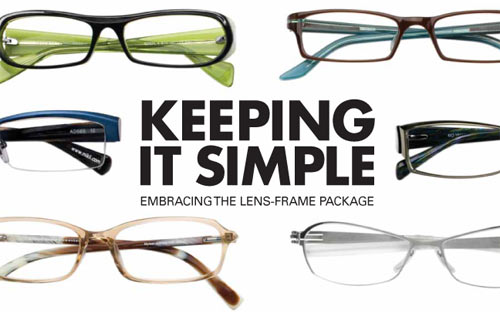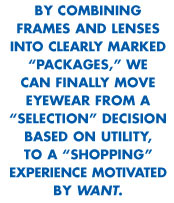
Clockwise from top left: EDEN 4—Face a Face/ Shamir Insight lenses; PRODESIGN 1649—ProDesign Denmark/Signet Armorlite lenses; KIO YAMOTO TITANIUM KT-280U—Kio Yamoto/ Vision-Ease Lens lenses; NORA—ic! berlin/Hoya Vision Care lenses; MYLES—Edward Beiner Lunettes/ X-Cel Optical lenses; ALAIN MIKLI AO666—Alain Mikli International/Carl Zeiss Optical lenses
By Barry Santini
When you last went looking for a new car, how would you rate your shopping experience? Was it enjoyable? Or was it colored by the overwhelming choices you faced? When was the last time a client told you they truly enjoyed shopping for eyewear? More commonly than we would prefer to admit, we hear customers say “I hate shopping for eyewear” and “Nothing I’ve ever picked out looks good on me.”
Many people feel overwhelmed by the decision-making process of selecting eyewear and lenses. Their lack of confidence, both within themselves as well as with dispensers and stylists, is no more evident than when we hear them say: “I really should have my (sister, daughter, wife, spouse, friend, etc.) here to help me.” Why is it many people seem to feel the talent and experience of their eyecare professional is not adequate when choosing fashion eyewear? There are many reasons that underlie their feelings, such as the amount of choices they face, and their unwillingness to face them (because they really don’t want eyewear in the first place).
How can we transform the drudgery of “getting glasses” into the excitement of “going shopping for eyewear”? By presenting lens and frames packages associated with fashion or themes. We’ve arrived at the point where our industry must fundamentally rethink the entire process of purchasing eyewear. To help our clients quickly and easily navigate the eyewear selection process, we should not only reduce the number of eyewear choices they’ll face, but also make them more intuitive. To accomplish this, we should try freeing ourselves from the habit of primarily approaching eyewear as a medical device. By combing frames and lenses into clearly marked “packages,” we can finally move eyewear from a “selection” decision based on utility, to a “shopping” experience motivated by want.
The Lure of a Fashion Brand
Walk into any upscale store and observe how their apparel choices are organized and displayed. It’s done according to the featured brand’s distinct fashion and lifestyle position. Each brand strives to communicate a specific and concise message. Calvin Klein, for example, is for youthful, casual, fun. Tommy Bahama embodies a casual/relaxed vacation-like feeling. Giorgio Armani attempts an elegant/upscale, almost bespoke/custom-fitted position. Fashion brands worked diligently to cultivate and nurture their specific lifestyle message. Their logos, colors and textures are all chosen to help convey their primary lifestyle position. And the money they amass behind their marketing and advertising is not insignificant. Often, as a brand name evolves, the manufacturer or distributor has a desire to expand the brand’s name recognition to a different demographic group. This is termed “brand extension.” For example, when Giorgio Armani wanted to attract a younger clientele, it established the “Emporio Armani” brand, which featured hipper styling and lower price points. Younger clients immediately recognized that Emporio Armani was meant for them.
Rethinking the Frame Bar: Grouping Frames According to Their Fashion Brand

Most optical stores operate as small businesses. Even regional chains, with several stores, have limited dollars to spend on advertising. Often, optical advertising consists of discount offers or insurance redemption. These messages do nothing to help potential clients feel more comfortable with their eyewear shopping experience. If anything, this type of advertising diminishes the value of eyewear in the public’s eye.
So, with a limited advertising budget, why not consider capitalizing on the marketing and millions of dollars spent by the big fashion brands each year? It’s easy to do by simply rethinking your frame displays and trying to group eyewear styles by their brand, rather than their utility, gender, price point, etc. The biggest sin we commit in optical in making eyewear selection confusing and unrewarding is to display frames in a cluttered or unorganized manner. We may be “too close to the forest to see the trees” with respect to understanding that our ubiquitous frames bars are, as a display modality, past their “expiration date.”
When a client comes into your dispensary to select new eyewear, they’ll find that eyewear grouped according to fashion brand is easily understandable, intuitive and is similar to their shopping for apparel or accessories. Now, the battle of “where to begin” when choosing frames is transformed into a more exciting shopping experience and one with which they are already familiar. Using fashion-brand grouping can allow presentation of easy-to-embrace packages of lens and frames. For instance, youthful brands like Calvin Klein or Miu Miu, which currently offers styles featuring a wide palette of bright colors, makes an AR or Transitions/AR lens package a natural for a client’s casual/relaxed lifestyle usage. Similarly, a poly/AR lens package with polished edges is ideal for bundling with upscale brands such as Chanel or Giorgio Armani.
Kids are Exceptional
A possible exception to the fashion-brand groupings above is your presentation of eyewear for children. Grouping various eyewear brands for children in one area preferred for both kids and their parents. With today’s low-cost pricing on polycarbonate lenses, why not try pricing all your children’s (age 12 and under) eyewear complete with polycarbonate lenses? In my store, the kid’s frame/lens packages reflect a 50 percent savings in the lens cost. Here, we add $40 to the normal frame price instead of our lenses-only price for kids of $79. If a small teen or adult style is preferred instead, from Coach, Valentino or Juicy Couture, for instance, we just add $40 to the frame cost to arrive at the kid’s package. It’s very simple to implement and understand for kids, parents and your staff.
The Reluctant Presbyope
When people finally begin to accept they’ve reached the stage where “their arms are too short” to read comfortably, this is very important opportunity for you to introduce them to an eyewear shopping experience that is fun. Simplifying the process with packages that include single-vision or progressive choices will motivate this reluctant shopper from approaching eyewear as an inconvenient item of reading utility, to experiencing the ultimate fun of personal expression: choosing a fashion accessory for their face. As above, including single-vision polycarbonate lenses at half their lenses-alone cost makes choosing a favorite frame or two quick and easy. You can even consider packaging progressive lenses in a similar manner. For example, if your entry level progressive lens retails for $200, then consider offering lenses at half-cost with the selection of two eyewear styles.
Barry Santini is a New York State licensed optician based in Seaford, N.Y.













